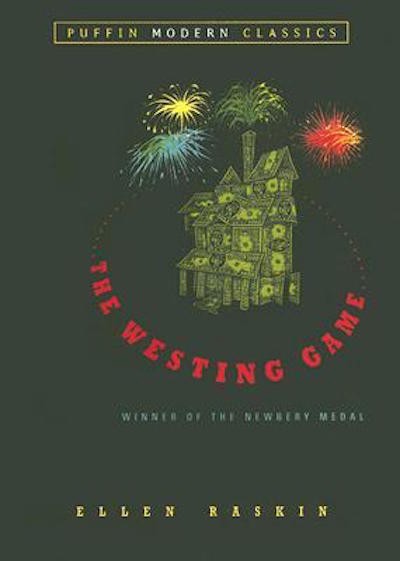What Children’s Literature Teaches Us About Money: Ellen Raskin’s ‘The Westing Game’
Good gracious from hood space.

Did you know that Ellen Raskin was really into the stock market? Just like Turtle Wexler?
(Sorry, this is the part where I’m supposed to introduce the column and discuss just how many times I read The Westing Game as a child—but let’s jump ahead.)
The edition of The Westing Game that I read as a child did not include this information—because I am very much the type of person who reads all introductions and dedications, even as a little kid—but Ann Durell’s introduction to the 2003 paperback edition of The Westing Game notes that Raskin “made a solid piece of capital on the stock market,” which I find delightful because The Westing Game is, as readers know, about how to grow your capital through investment.
No, wait. It’s about murder.
Or chess.
Or “America the Beautiful.”
Or the way racism and ableism and classism prevent us from fully understanding each other.
Or solving the mystery before the characters do.
Or re-reading the book, because you’re nine years old, and realizing that Raskin gave you all the information you needed to solve the mystery before the characters do and you still couldn’t do it.

If you have never read The Westing Game, be aware that it is one of the most brilliantly plotted mysteries I’ve ever read. The plotting still amazed me when I re-read the book this week, and I’ve read it so many times I have Westing’s clues memorized. (Sometimes I say “Good gracious from hood space” when I don’t want to use an obscenity.)
It’s also written for children, at least theoretically; it’s one of those children’s books where most of the characters are adults, and it deals with alcoholism and ulcers and bookies and sentences like “Gracie’s right, he is a loser. Next she’ll mention having to give up her family because she married a Jew — no, she never brings that up, Gracie with all her faults would never do that.”
But it’s also not quite an adult story, first because there’s a thirteen-year-old girl named Turtle Wexler at its center and second because it is a murder mystery that no adult would handle quite in the way that these adults do. No adult would get a check for $10,000 in exchange for participating in Sam Westing’s “solve my murder” game and not ask about the taxes, right? I mean, are these income taxes or inheritance taxes or both or what?
The Westing Game was first published in 1978, and puts us in a world where adults have time to solve murder mysteries while holding down full-time jobs; where kids ride their bikes four miles to school unsupervised; where nobody goes to college unless they can pay for it in advance, or work their way through a year at a time.
The Wexler family is middle class—as Raskin writes them, comically so—but even they can only afford to send their daughter Angela to her first year of college, though she eventually funds the rest of her degree on her own. Judge J.J. Ford owes her college education entirely to Sam Westing, and at the end of the story we learn that putting J.J. through both undergrad and law school cost Westing exactly $10,000.
These magical round numbers are one of the details that makes this a children’s story, not an adult’s story. The only non-round number, and I’m including Hoo’s On First through Hoo’s On Tenth, is the amount of money Turtle Wexler makes on the stock market after following Sam Westing’s clues: $11,857.50. Technically she only increases her initial $10,000 investment by $1,857.50, but that’s still “an appreciation of twenty-seven point eight percent calculated on an annual basis.”
But back to the college thing for a second, and the middle class thing, and the “wow, this book really was published in 1978” thing. The Wexlers can’t pay for college, but they never worry about having enough money to make rent. The Theodorakis family is putting most of their money towards their son Chris’s medical expenses—Theo Theodorakis even turned down a partial college scholarship so the family could save money—but when other characters break their ankles or have bombs go off in their faces (this is a murder mystery after all, there has to be a few mysterious bombs) they don’t worry about the expense or the ambulance. No one says “well, that’s my $5,000 deductible gone.”
$10,000 in 1978 is the equivalent of $37,000 now, which means that Sam Westing couldn’t have put J.J. Ford through multiple college degrees on that money—and neither Angela nor Theo could fully fund their colleges either—but it’s also a year’s worth of income for a doorman like Sandy McSouthers, both then and now, which makes J.J. Ford’s decision to give her $10,000 to Sandy even more significant.
Many of the characters are extraordinarily generous with each other, both with their Westing windfalls and with their time and attention—and that’s because the book is really about how people can connect with and learn from each other, the whole murder plot is just a way to get them all talking—and on the re-read, that generosity feels both inspirational and a bit dated. Could a junior high school student like Turtle and a small-business owner like Flora Baumbach really have enough spare time to form a close friendship today? Turtle would have three hours of homework after school, on average, plus extracurriculars; Flora would probably keep her dressmakers’ shop open until 9 p.m. because that’s when her customers would be available for fittings. They could both live in Sunset Towers and never pass in the hallway.
I guess what I mean is that it’s not 1978 anymore, and people don’t come together to solve murder mysteries the way they used to.
There’s no big money lesson in this book, perhaps because none of the characters have any real money problems; all of the colleges eventually get paid for, Sam Westing ends up giving them the apartment building, and everybody lives happily ever after. Even the struggling soup kitchen gets funded.
But there are a lot of lessons about how to be a good person and how to learn from other people, both as a thirteen-year-old girl and as an adult, which was probably why I re-read this book so many times as a child. I told you this story was about how to grow your capital through investment, after all. I just didn’t clarify that we’re supposed to invest in each other.
Who else read this book? Do you love it as much as I do? Are there any big money lessons I missed? Did anyone end up seeing the 1997 movie version?
Next week: Harriet the Spy.
Previously:
- What Children’s Literature Teaches Us About Money: Eleanor Estes’ ‘The Hundred Dresses’
- What Children’s Literature Teaches Us About Money: Patricia MacLachlan’s ‘Sarah, Plain and Tall’
- What Children’s Lit Teaches Us About Money: ‘From the Mixed-Up Files of Mrs. Basil E. Frankweiler’
- What Children’s Literature Teaches Us About Money: Roald Dahl’s ‘Charlie and the Chocolate Factory’
Support The Billfold
The Billfold continues to exist thanks to support from our readers. Help us continue to do our work by making a monthly pledge on Patreon or a one-time-only contribution through PayPal.
Comments